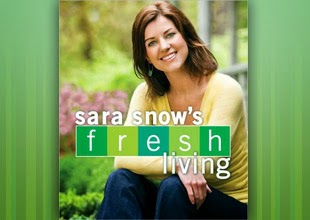Sara Snow’s Fresh Living
A Review
Written by Gayle
This year at the Natural Foods Expo West Show, I was able to hear Sara Snow speak. She was warm and friendly, and I came out of the session feeling that there was even more that I could do to make our home and family and lives more healthy and greener. I try to make choices that are not only good for us but good for the planet, and she inspired me to do more.
I also got her book, Sara Snow’s Fresh Living. This is a handy, easy to read and use guidebook for making healthy, green choices all throughout the house. She starts in the kitchen. While it has been almost five years since the publication of this book, Sara’s advice is still sound. For example, as we all know, GMOs (Genetically Modified Organisms, sometimes called GM foods) are a big topic today and are likely to remain so for some time. But five years ago, Sara published this (pages 54-55):
“While there are ongoing conversations about whether GM food should be called out as such on food labels, the USDA prohibits the use of genetically modified food ingredients in organic foods. So one sure way to avoid GM foods is to buy organic, especially in foods containing cron, soy, and canola or cottonseed oils.”
Did you get that? “The USDA prohibits the use of genetically modified food ingredients in organic foods. So…
Organic has ALWAYS been non-GMO
Want to avoid GMOs? It’s as easy as buying organic. When you do, you never have to wonder if your food contains GMOs.
Sara also highlights the Environmental Working Group’s guide to pesticides in produce (www.foodnews.org). They produce a shopper’s guide to the “Dirty Dozen” items in produce departments that have the highest concentrations of pesticides. Here is their 2013 list (which includes two extra items):
- apples
- celery
- cherry tomatoes
- cucumbers
- grapes
- hot peppers
- nectarines (imported)
- peaches
- potatoes
- spinach
- strawberries
- sweet red peppers
- kale/collard greens/other leafy greens
- summer squash (zucchini, yellow crookneck)
Would you like to avoid pesticides? Buy Organic–and Lassen’s produce is always organic.
Other Kitchen Tips
Sara has lots of other sound tips to a healthier, more green kitchen, such as just scraping (not rinsing) dishes before you put them in the dishwasher. You can save up to 20 gallons of water by skipping the rinse. Store your leftovers in glass, not plastic. Use waxed paper and cloth towels instead of plastic wrap and paper towels. Choose vegetables over meat. Did you know that “farmers require forty times as much water to produce a pound of beef as they do to grow a pound of potatoes”? And of course, use reusable bags instead of increasing that exploding collection of plastic bags under the sink.
The Rest of the House
Sara devotes a chapter to each of the following rooms in the house, as well as outdoors–the bathroom, bedroom, nursery, living room, laundry room, and the office. Here is a small sampling of her suggestions.
- Conserve water–turn off the water and take shorter showers. If you have an old shower head, replace it with a low-flow option. Same thing with an old toilet.
- Use personal care products that are free from toxins and dangerous chemicals–for your health and the safety of the planet. (An organization that lobbies to get dangerous chemicals out of personal products is Women’s Voices for the Earth. If you are willing to get freaked out by the multitude of dangerous chemicals in everyday products, check out their website. Or you can click here for my blog post about the work that they are doing.) Sara lists nine “red light ingredients” that we should avoid in our personal care products: Fragrance, Phthalates, Parabens, Petroleum, SLS (Sodium Lauryl/Laureth Sulfates), Mercury, Formaldehyde, Hydroquinone (skin whiteners), and Lead. Read the label and don’t purchase items with these ingredients. The United States has been slow in banning these ingredients.
- Buy Organic cotton or bamboo bedsheets.
- Reduce light, heat, and noise–you will sleep better
- Wear clothes longer, and recycle and reuse clothing, especially for children who grow quickly.
- Make sure the paints you use in your house are latex, not oil based. Look for paints that are labeled low- or no-VOC ((Volatile Organic Compounds–ingredients that turn to gasses at room temperature, especially when they come into contact with sunlight.)
- Use gel-free, chlorine bleach-free diapers.
- Use natural decor–live plants are great for improving the air in your home.
- Buy recycled or reclaimed furniture.
- Open or close windows to control the temperature in your home rather than the thermostat, when possible.
- Use cold water to wash clothes as often as possible, and line dry.
- Use vinegar-water (50/50 ratio), not chemicals, to clean.
- Reduce the use of anti-bacterial products. We are likely getting an overload and the bacteria is becoming resistant.
- Recycle all paper, and buy recycled paper. Print double sided.
- Pay bills online and get bills sent electronically
- Take fewer errand trips–combine so that you don’t spend as much time in the car.
- Walk or ride your bike as much as possible (get a basket for your bike to carry purchases!)
- Don’t use toxic chemicals on your yard
- Compost (for our blog post on composting, click here.)
- Install gutters and downspouts and save rainwater to use on your garden
There is so much more!
Sara has many many more ideas for living green. I would recommend her book for the practical tips and her easy to understand style. It’s easy to be overwhelmed with all of the possible things that we probably should be doing to live greener, but she makes it simple to start.
Let’s keep it green!
Love,
Lassen’s


Thank you for the tips for a better and healthier lifestyle!!